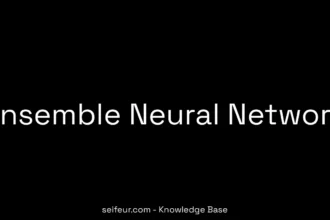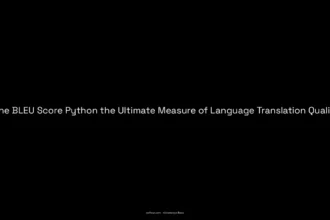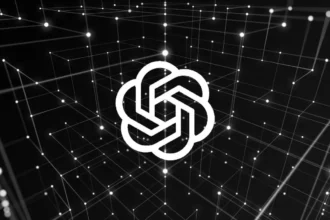Are you ready to dive headfirst into the fascinating realm of data encoding? Brace yourself for a mind-bending adventure as we unravel the mysteries of ordinal encoding. Whether you’re a data enthusiast, a curious learner, or a tech-savvy professional, this blog post is your ticket to understanding the concept of ordinal encoding like never before.
But wait, what exactly is ordinal encoding, you ask? Well, imagine a world where numbers and labels play a crucial role in organizing and analyzing data. Picture a scenario where we assign a unique numerical value to each category, transforming words into digits that computers can effortlessly comprehend. Intriguing, isn’t it? In this article, we’ll not only demystify the concept of ordinal encoding but also explore its advantages over other encoding techniques.
We’ll delve into the four primary types of encoding and shed light on the wonders of UTF-8 and UTF-32 encoding. Get ready to witness the power of transforming data into meaningful insights with just a few clever tricks. So, get comfortable, grab your favorite beverage, and let’s embark on this exhilarating journey together. By the end of this post, you’ll be armed with the knowledge to manipulate data like a pro, leaving your peers in awe. Let’s unlock the secrets of ordinal encoding and take our data analysis game to the next level!
Table of Contents
ToggleUnderstanding the Concept of Ordinal Encoding
Imagine you’re a data scientist facing a dataset brimming with categorical features. Your mission: to unveil patterns hidden within, but there’s a catch—the machine learning algorithms at your disposal thirst for numerical data. Here lies the power of ordinal encoding, a technique that quenches this thirst by transforming categorical features into a numerical format that algorithms can digest.
Why does order matter? Think about a line of dominoes; each piece is essential to the cascade. In ordinal encoding, similar to carefully aligning dominoes, we assign numbers to labels based on their hierarchical sequence. For example, educational levels such as ‘high school’, ‘bachelor’s’, and ‘master’s’ possess a natural order that is crucial to maintain. Ordinal encoding respects this hierarchy, ensuring that ‘master’s’ holds a higher numerical value than ‘high school’.
The elegance of this method is in its simplicity and its profound ability to maintain the intrinsic order of the data. When dealing with categorical ordinal data, such as survey responses that range from ‘very dissatisfied’ to ‘very satisfied’, the magic of ordinal encoding lies in preserving the sentiment gradient expressed by the respondents.
| Fact | Description |
|---|---|
| Ordinal Encoding | Technique to convert categorical features into a numerical format based on their ordinal relationship. |
| Applicable Data | Used when the categorical feature is ordinal and the sequence order is important, such as ‘poor’ to ‘excellent’ ratings. |
| One-hot vs. Ordinal Encoding | One-hot encoding is ideal for nominal data, while ordinal encoding is suitable for data where order is significant. |
| One-hot Encoding for Ordinal Data | Though one-hot encoding can be used for any categorical data, it does not preserve the order of ordinal data. |
The choice of encoding can dramatically shape the performance of your machine learning models. One-hot encoding, another popular technique, thrives in handling nominal data where no order is implied, such as the colors of a rainbow. However, when you’re dealing with a spectrum of satisfaction or educational levels, ordinal encoding is your trusted ally, skillfully encoding the ‘less than’ and ‘greater than’ relationships inherent to the data.
By selecting the right tool for the job—a decision that should never be taken lightly—you empower your models with the ability to recognize and exploit the subtle nuances of your data. This choice is not just a technicality; it’s a strategic move in the grand chess game of data science.
As we forge ahead into the realms of Ordinal Encoding Vs. Other Encoding Techniques, keep the essence of ordinal encoding in mind: it is a method that not only translates labels into numbers but does so by honoring the rank and file of categorical data, thus preserving the rich tapestry of information it holds.
Ordinal Encoding Vs. Other Encoding Techniques
When we plunge into the sea of data encoding, we navigate through various techniques, each with its own compass, guiding us towards effective data interpretation. Among these, ordinal encoding and label encoding seem like two ships sailing in the same direction, but with subtle, pivotal differences.
Consider label encoding the seasoned sailor, adept at transforming categorical data into a numerical format. This technique is particularly useful for ordinal data, where the natural order carries intrinsic value. For instance, in a dataset where sizes such as small, medium, and large need to be encoded, label encoding ensures that small is assigned a lower value than medium, which in turn is lower than large, maintaining the hierarchy essential for model comprehension.
On the other hand, ordinal encoding stands as the versatile vessel, capable of traversing both the ordinal and nominal data ocean. While it shares label encoding’s ability to preserve the order of categories, it sails a step further. Ordinal encoding is also adept at handling nominal data, where the categories do not have an inherent order, by not imposing a numerical sequence that could mislead the model’s learning process.
Now, let’s set our sights on one-hot encoding. Picture a fleet of ships, each representing a category within a dataset. In one-hot encoding, only one ship is allowed to raise its flag at a time, symbolizing the presence of a category. This technique shines when dealing with nominal data, where categories hold no rank or order. It creates a binary vector for each category, marking the presence of a category with a 1 and the absence with a 0. This avoids the accidental assignment of order that could occur with ordinal or label encoding and ensures that the machine learning model treats each category as distinct.
Each encoding technique carries its own set of coordinates, guiding data scientists to the most accurate representation of categorical data. The choice of encoding is a strategic decision that can enhance the model’s ability to discern patterns and make predictions. By selectively harnessing the power of ordinal and one-hot encoding, we can create a robust framework for our models to interpret the rich tapestry of categorical information.
As our journey through the encoding techniques continues, remember that the destination is not just about converting data but about preserving its essence. The voyage of a data scientist is to choose the path that best suits the nature of the data, ensuring the journey from raw data to predictive insights is as smooth and accurate as possible.
The Four Primary Types of Encoding
Embarking on a journey through the labyrinth of encoding reveals a plethora of applications, stretching beyond the confines of data preprocessing. It’s a concept that resonates across diverse realms, from the intricate workings of the human mind to the vast expanse of digital communication. Let’s delve into the four cardinal types of encoding, each serving a unique purpose in its domain.
Visual Encoding: Painting with Memory’s Brush
Visual encoding is akin to a painter converting a stunning vista into a breathtaking canvas. In cognitive psychology, this type of encoding is the transformation of sensory input into memorable images. A simple glance at an apple, its vivid red hue, and glossy surface can be encoded as a visual memory, to be retrieved when the fruit’s name is mentioned. This method is instrumental in the way we store and recall visual information, a vital aspect of memory formation.
Acoustic Encoding: The Symphony of Sounds
Similarly, acoustic encoding is the mind’s orchestration of sounds into lasting auditory memories. The melody of a loved one’s laughter, the cadence of a poignant piece of music—these sounds are encoded acoustically, enabling us to recognize and differentiate a symphony of auditory cues in our environment.
Elaborative Encoding: Weaving Complex Tapestries
Then there’s elaborative encoding, which involves a deeper level of processing. It’s not just about seeing or hearing; it’s about embellishing information with meaning and connecting it to existing knowledge. Imagine linking the concept of gravity not just to the word, but to the sensation of your feet firmly planted on the ground, and to Newton’s fabled apple. This intricate web of associations enhances our ability to remember and understand complex information.
Semantic Encoding: The Essence of Understanding
Finally, semantic encoding is the process of encoding the essence, the meaning of an event or piece of information. It transcends mere visual or acoustic representation to encode the core significance, the underlying concept. It’s what allows us to comprehend the abstract or to grasp the symbolism in literature.
These encoding types are not just theoretical constructs; they are the bedrock of practical techniques designed to optimize memory storage. Mnemonics transform information into an easier-to-remember format, often using vivid imagery or acronyms. Chunking breaks down large pieces of information into smaller, more manageable units. Meanwhile, state-dependent learning suggests that our ability to retrieve information is enhanced when we are in the same state of consciousness as when we encoded it.
In the digital realm, encoding takes on a slightly different hue. It’s the art of transforming data into a format suitable for efficient transmission, storage, or encryption. Here, UTF-8 and UTF-32 emerge as popular encoding schemes. UTF-8 is the heavyweight champion on the World Wide Web, reigning supreme with its usage in a staggering 98.0% of web pages as of October 2023. Its prevalence is a testament to its efficiency and compatibility across different platforms and devices.
Meanwhile, UTF-32 is the meticulous librarian of the encoding world, assigning a generous 32 bits to every character for a fixed-length approach. Although not as widely used due to its larger size, UTF-32 is appreciated for its simplicity in mapping Unicode characters directly to code points without the need for complex algorithms.
Whether in the cognitive constructs of our minds or the binary digits of our computers, encoding remains a foundational aspect of how we interpret and interact with the world. As we continue to explore the intricacies of ordinal encoding and its brethren, it’s clear that these processes are critical in shaping our understanding and communication, in both the human and digital realms.
With the stage set by these four primary types of encoding, we now turn our attention to the specifics of UTF-8 and UTF-32, further unraveling the threads of this complex tapestry.
Understanding UTF-8 and UTF-32 Encoding
In the grand tapestry of digital communication, UTF-8 stands out as the ubiquitous thread that weaves together the World Wide Web. It is the champion of encoding, boasting a staggering presence on 98.0% of all web pages. Imagine UTF-8 as a chameleon, with its variable-length nature allowing it to represent every character in the Unicode standard, while maintaining a harmonious backward compatibility with the venerable ASCII. This seamless adaptability makes UTF-8 the encoding of choice for developers looking to craft websites that speak the universal language of the internet.
Contrastingly, UTF-32 is like a steady, unchanging monolith in the realm of encoding. It is a fixed-length encoding, dedicating a uniform 32 bits (four bytes) to each Unicode code point. While UTF-32 stands out for its simplicity, it’s akin to using a large suitcase for a short trip—somewhat inefficient, given that it only needs 21 bits for the entirety of Unicode code points. The simplicity of UTF-32, while appealing, means that it’s often overshadowed by the efficiency and agility of UTF-8.
Consider the art of storytelling. Just as a skilled narrator selects the right pace and tone, the choice between UTF-8 and UTF-32 encoding schemes can shape the narrative of our digital interactions. UTF-8 is the favored bard, telling tales efficiently, pausing only briefly for the most complex characters. UTF-32, meanwhile, is the methodical scribe, dedicating equal space to each letter of the story, regardless of its prominence.
Understanding these encoding strategies is not just an academic exercise. It is a practical skill that lies at the heart of machine learning, cognitive psychology, and digital communication. Whether it’s a matter of preparing ordinal categorical data for analysis or striving to perfect the retention of memories, the appropriate encoding technique is a powerful tool in our cognitive arsenal. Embracing the nuances of UTF-8 and UTF-32 can empower us to navigate the digital landscape with confidence and clarity.
For those who are steeped in the world of data, this knowledge is indispensable. From the intricate dance of machine learning algorithms to the vast library of human knowledge stored online, encoding is the key that unlocks understanding and interaction. As we continue our exploration of encoding, let us appreciate the precision and elegance that these systems bring to our interconnected world.
Q: What is ordinal encoding?
A: Ordinal encoding is a technique used to convert categorical features into a numerical format. It assigns labels to numbers based on their ordinal relationship to one another.
Q: How does ordinal encoding differ from one-hot encoding?
A: One-hot encoding is suitable for nominal data and does not introduce bias, while ordinal encoding is used to preserve order information among categories. The choice of encoding technique depends on the nature of the data and the need to retain order.
Q: What encoding technique is used for ordinal data?
A: Label encoding or ordinal encoding is used for ordinal data. This technique assigns each label a unique integer value, reflecting the sequence and order of the categories.
Q: Can you provide an example of an ordinal encoder category?
A: Sure! An example of ordinal encoding would be assigning the values “lowerlevel” as 0, “MiddleSchool” as 1, and “HighSchool” as 2. This assumes an ordering of the categories based on their labels.





